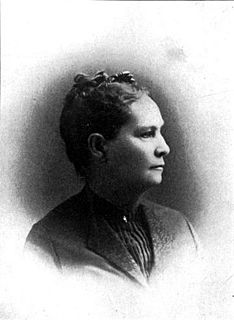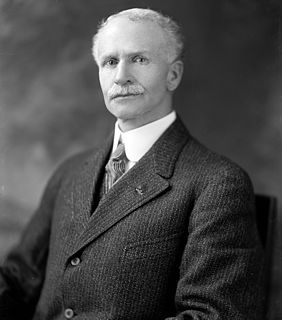
The League of Women Voters (LWV) is an American civic organization that was formed to help women take a larger role in public affairs after they won the right to vote. It was founded in 1920 to support the new women suffrage rights and was a merger of National Council of Women Voters, founded by Emma Smith DeVoe, and National American Woman Suffrage Association, led by Carrie Chapman Catt, approximately six months before the Nineteenth Amendment to the United States Constitution gave women the right to vote. The League of Women Voters began as a "mighty political experiment" aimed to help newly enfranchised women exercise their responsibilities as voters. Originally, only women could join the league; but in 1973 the charter was modified to include men. LWV operates at the local, state, and national level, with over 1,000 local and 50 state leagues, and one territory league in the U.S. Virgin Islands.

Proposition 22 was a law enacted by California voters in March 2000 to prevent marriage between same-sex couples. In May 2008, it was struck down by the California Supreme Court as contrary to the state constitution.

Proposition 209 is a California ballot proposition which, upon approval in November 1996, amended the state constitution to prohibit state governmental institutions from considering race, sex, or ethnicity, specifically in the areas of public employment, public contracting, and public education. Modeled on the Civil Rights Act of 1964, the California Civil Rights Initiative was authored by two California academics, Glynn Custred and Tom Wood. It was the first electoral test of affirmative action policies in America.
Same-sex marriage is legal in the U.S. state of California, and first became so on June 16, 2008, when the state began issuing marriage licenses to same-sex couples as the result of the Supreme Court of California ruling in In re Marriage Cases, which found that barring same-sex couples from marriage violated the state's Constitution. The issuance of those licenses was halted during the period of November 5, 2008 through June 27, 2013 due to the passage of Proposition 8—a state constitutional amendment barring same-sex marriages. The granting of same-sex marriages recommenced following the United States Supreme Court decision in Hollingsworth v. Perry, which restored the effect of a federal district court ruling that overturned Proposition 8 as unconstitutional.

California Proposition 14 was a November 1964 ballot proposition that amended the California state constitution, nullifying the Rumford Fair Housing Act. Proposition 14 was declared unconstitutional by the California Supreme Court in 1966. The decision of the California Supreme Court was affirmed by the U.S. Supreme Court in 1967 in Reitman v. Mulkey.

Clara Shortridge Foltz was the first female lawyer on the West Coast, and pioneered the idea of the public defender. The Criminal Courts Building in downtown Los Angeles was renamed after her in 2002, and is now known as the Clara Shortridge Foltz Criminal Justice Center.
The right of foreigners to vote in the United States has historically been a contentious issue. A foreigner, in this context, is an alien or a person who is not a citizen of the United States.

Proposition 4, or the Abortion Waiting Period and Parental Notification Initiative, also known to its supporters as Sarah's Law, was an initiative state constitutional amendment on the 2008 California General Election ballot

Proposition 8, known informally as Prop 8, was a California ballot proposition and a state constitutional amendment passed in the November 2008 California state elections. The proposition was created by opponents of same-sex marriage in advance of the California Supreme Court's May 2008 appeal ruling, In re Marriage Cases, which followed the short-lived 2004 same-sex weddings controversy and found the previous ban on same-sex marriage unconstitutional. Proposition 8 was ultimately ruled unconstitutional by a federal court in 2010, although the court decision did not go into effect until June 26, 2013, following the conclusion of proponents' appeals.

Arizona Proposition 102 was an amendment to the constitution of the state of Arizona adopted by a ballot measure held in 2008. It added Article 30 of the Arizona Constitution, which says: "Only a union of one man and one woman shall be valid or recognized as a marriage in this state." The amendment added a constitutional ban on same-sex marriage to existing statutory bans in place since 1996. In October 2014, Article 30 of the Arizona Constitution was struck down as unconstitutional in the United States District Court for the District of Arizona, and is no longer enforced by the state of Arizona, which now allows and recognizes same-sex marriages.
Strauss v. Horton 46 Cal.4th 364, 93 Cal.Rptr.3d 591, 207 P.3d 48, was the consolidation of three lawsuits following the passage of California's Proposition 8 on November 4, 2008, which went into effect on November 5. The suits were filed by a number of gay couples and governmental entities. Three of these six were accepted by the Supreme Court of California to be heard together. The oral arguments were made in San Francisco on March 5, 2009. These cases were new to the California Supreme Court, and Justice Kathryn Mickle Werdegar stated that it will set precedent as "no previous case had presented the question of whether an initiative could be used to take away fundamental rights".
Hollingsworth v. Perry were a series of United States federal court cases that legalized same-sex marriage in the State of California. The case began in 2009 in the U.S. District Court for the Northern District of California, which found that banning same-sex marriage violates equal protection under the law. This decision overturned ballot initiative Proposition 8, which had banned same-sex marriage. After the State of California refused to defend Proposition 8, the official sponsors of Proposition 8 intervened and appealed to the Supreme Court. The case was litigated during the governorships of both Arnold Schwarzenegger and Jerry Brown, and was thus known as Perry v. Schwarzenegger and Perry v. Brown, respectively. As Hollingsworth v. Perry, it eventually reached the United States Supreme Court, which held that, in line with prior precedent, the official sponsors of a ballot initiative measure did not have Article III standing to appeal an adverse federal court ruling when the state refused to do so.

Proposition 7 of 1911 was an amendment of the Constitution of California that introduced, for the first time, the initiative and the optional referendum. Prior to 1911 the only form of direct democracy in California was the compulsory referendum.

Proposition 14 is a California ballot proposition that appeared on the ballot during the June 2010 state elections. It was a constitutional amendment that effectively transformed California's non-Presidential elections from first-past-the-post to a nonpartisan blanket primary. The proposition was legislatively referred to voters by the State Legislature and approved by 54% of the voters.

The California Constitutional Conventions were two separate constitutional conventions that took place in California during the nineteenth century which led to the creation of the modern Constitution of California. The first, known as the Monterey Convention, held in September and October 1849 in advance of California attaining U.S. statehood the following year, adopted the state's original constitution. This document maintains jurisdiction along with the current constitution which was ratified on May 7, 1879, following the Sacramento Convention. Article 3 Section 2 of the current Constitution references the original boundaries as stated in the 1849 Constitution at Article 7. The result of Progressive mistrust of elected officials, this later constitution took a full year to finalize and is today the third longest in the world, and has been described as "the perfect example of what a constitution ought not to be". Multiple calls for a third state constitutional convention have been raised during the past quarter-century, but none has thus far gained widespread political momentum.

Ellen Clark Sargent was an active American women's suffragette. She was influential in advocacy for the Nineteenth Amendment to the United States Constitution, which sought to give women the right to vote.
This is a timeline of women's suffrage in the United States.
Women's suffrage in states of the United States refers to women's right to vote in individual states of that country. Suffrage was established on a full or partial basis by various towns, counties, states and territories during the latter decades of the 19th century and early part of the 20th century. As women received the right to vote in some places, they began running for public office and gaining positions as school board members, county clerks, state legislators, judges, and, in the case of Jeannette Rankin, as a Member of Congress.

California Proposition 59 is a non-binding advisory question that appeared on the 2016 California November general election ballot. It asked voters if they wanted California to work towards overturning the Citizens United U.S. Supreme Court ruling.

Sarah L. Knox-Goodrich (1825–1903) was a women's rights activist who worked for women's suffrage in California in the late nineteenth century. Her first husband, William Knox, was a business man, banker, and state politician. Her second husband, Levi Goodrich, was an architect in Southern California. Knox-Goodrich used her wealth and her social position to push for equal employment, school suffrage, and voting rights.


















